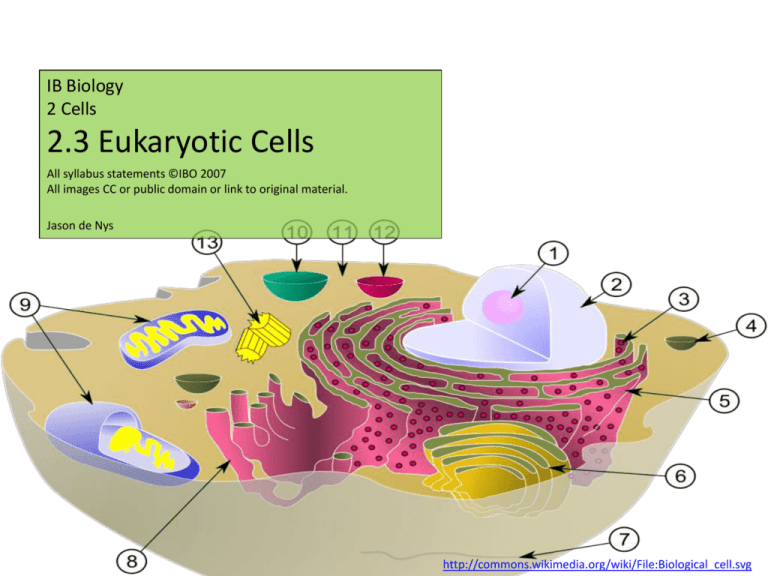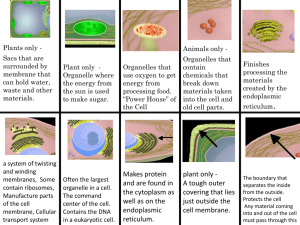Topic 2.3 - biology4friends
advertisement

IB Biology 2 Cells 2.3 Eukaryotic Cells All syllabus statements ©IBO 2007 All images CC or public domain or link to original material. Jason de Nys http://commons.wikimedia.org/wiki/File:Biological_cell.svg 2.3.1. Draw and label a diagram of the ultrastructure of a liver cell as an example of an animal cell 2.3.2 Annotate the diagram from 2.3.1 with the functions of each named structure. The Nucleus contains the chromosomes which comprise most of the DNA in a cell - It is the largest organelle - It has a double layer membrane - mRNA, transcribed from the DNA in the nucleus, exits through pores more in 3.3, 3.4 and 7.1 and 7.2 - Some cells have multiple nuclei The bright blue stains are nuclei in HeLa cells. Read “The Immortal Life of Henrietta Lacks” for a fascinating story of the origin of HeLa cells http://commons.wikimedia.org/wiki/File:HeLa_cells_stained_with_Hoechst_33258.jpg http://commons.wikimedia.org/wiki/File:Diagram_human_cell_nucleus.svg The Cell membrane is the boundary of the cell. • It acts as a “gatekeeper”, preventing the entry or exit of some molecules and facilitating the movement of others. • It is a phospholipid bilayer • It is permeable to oxygen and carbon dioxide • It is impermeable to water and charged particles, they must enter through special proteins embedded in the membrane More in 2.4 http://commons.wikimedia.org/wiki/File:Cell_membrane_detailed_diagram_en.svg The Mitochondrion (pl. Mitochondria) • The ‘power house’ of the cell • Has a smooth outer membrane and a folded inner membrane • Where aerobic respiration occurs in the cell More in 3.7 and 8.1 Mitochondria in mammalian lung cells Remember: Where else do we see loops of DNA? How does the size of a mitochondrion compare with an average prokaryote? The implications of the answers to these questions are in Option D: Evolution http://commons.wikimedia.org/wiki/File:Animal_mitochondrion_diagram_en.svg http://commons.wikimedia.org/wiki/File:Mitochondria,_mammalian_lung_-_TEM.jpg Rough Endoplasmic Reticulum Spot the difference? Smooth Endoplasmic Reticulum http://images.wellcome.ac.uk/ The ‘spots’ are the difference! The Rough Endoplasmic Reticulum is peppered with ribosomes that give it the rough appearance It is where protein synthesis occurs more in 3.5 and 7.4 The (free) Ribosome, the molecular machine responsible for protein synthesis much, much more in 3.5 and 7.4 A ribosome on the sculpture “Waltz of the Polypeptides” at Cold Spring Harbor Laboratory http://www.flickr.com/photos/cryo_mariena/6033827307/sizes/m/in/photostream/ I shall name it……… The internal reticular apparatus!! Pretty catchy… no?* Camillo Golgi *Everybody thought that was a terrible name, so they called it the Golgi apparatus instead http://commons.wikimedia.org/wiki/File:C_Golgi.jpg http://commons.wikimedia.org/wiki/File:Golgi_in_the_cytoplasm_of_a_macrophage_in_the_alveolus_(lung)_-_TEM.jpg The Golgi Apparatus is a flattened stack of membranes responsible for the packaging and delivery of proteins http://en.wikipedia.org/wiki/File:Nucleus_ER_golgi.svg Lysosomes are simple, membrane-bound organelles full of enzymes that digest engulfed bacteria and viruses and large molecules for recycling. http://commons.wikimedia.org/wiki/File:Lysosome.jpg Image from an amazing site by teacher Andrew Brown http://www.tokresource.org/tok_classes/biobiobio/biomenu/eukaryotic_cells/index.htm 2.3.3 Identify structures from 2.3.1 in electron micrographs of liver cells. Rough Endoplasmic Reticulum Mitochondrion Smooth Endoplasmic Reticulum What can you see? 2.3.4 Compare prokaryotic and eukaryotic cells Compare Give an account of similarities and differences between two (or more) items, referring to both (all) of them throughout Prokaryotic Eukaryotic Small cells Relatively larger cells Always unicellular Some multicellular, some unicellular No nucleus: DNA a ‘naked’ loop in the nucleoid region DNA in chromosomes in a membranebound nucleus Ribosomes smaller (70s) Ribosomes larger (80s) No mitochondria, respiration in cell membrane and mesosomes Mitochondria, where aerobic respiration occurs Cell division by binary fission Cell division by meiosis or Mitosis Reproduction asexual (some gene exchange can occur via conjugation) Reproduction Sexual or asexual Table modified from Click4Biology 2.3.5 State three differences between plant and animal cells State: Give a specific name, value or other brief answer without explanation or calculation. Animals Plants Have a cell wall Don’t have a cell wall Have chloroplasts in photosynthetic cells Don’t have chloroplasts anywhere Carbohydrate stored as starch and plant oils V. Carbohydrate stored as glycogen and animal fat Rigid Shape (due to cell wall) Flexible shape Have a large permanent storage vacuole May have small, temporary vacuoles http://www.flickr.com/photos/chubbybat/45407031/ http://www.flickr.com/photos/powi/749366522/ 2.3.6 Outline two roles of extracellular components Outline: Give a brief account or summary. Got a banana? Bone cells have an extracellular matrix in the interstitial spaces (between the cells)of collagen and calcium phosphate; which together form the hard bone. http://www.flickr.com/photos/limonada/14705232/ The other form of extracellular matrix is the basement membranes They exist in many tissue types as a form of support e.g. as the lining in blood vessels You may already know about the glomerulus in the kidney. A basement membrane is integral to ultrafiltration there. More in HL 11.3 http://commons.wikimedia.org/wiki/File:Gallbladder_cholesterolosis_low_mag.jpg As well as extracellular matrices in animals, plant have extracellular components…. Cell Walls They are made of cellulose and provide structure, support and protection. They maintain cell shape and prevent turgor pressure from rupturing the cell http://www.flickr.com/photos/ah_pao/2590017159/ Further information: Three of the best sites for IB-specific Biology information. The top link takes you to the PPT by Stephen Taylor







